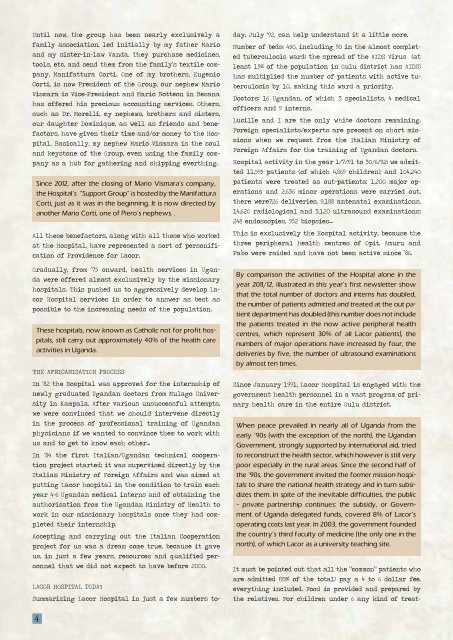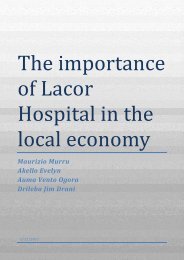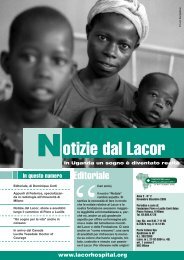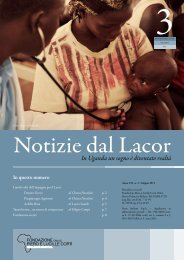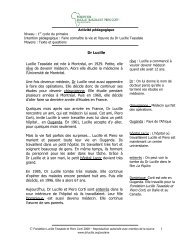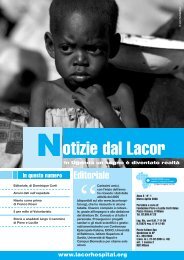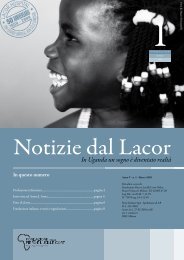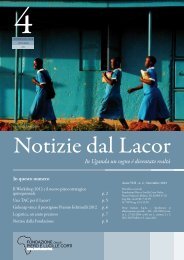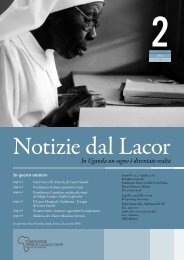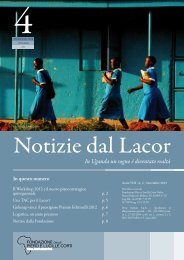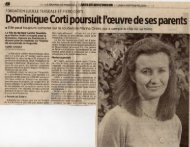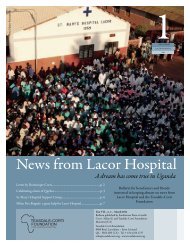News from Lacor Hospital - Fondazione Corti
News from Lacor Hospital - Fondazione Corti
News from Lacor Hospital - Fondazione Corti
You also want an ePaper? Increase the reach of your titles
YUMPU automatically turns print PDFs into web optimized ePapers that Google loves.
Until now, the group has been nearly exclusively a<br />
family association, led initially by my father Mario<br />
and my sister-in-law Vanda. They purchase medicines,<br />
tools, etc. and send them <strong>from</strong> the family’s textile company,<br />
Manifattura <strong>Corti</strong>. One of my brothers, Eugenio<br />
<strong>Corti</strong>, is now President of the Group, our nephew Mario<br />
Vismara is Vice-President and Mario Botteon in Besana<br />
has offered his precious accounting services. Others,<br />
such as Dr. Morelli, my nephews, brothers and sisters,<br />
our daughter Dominique, as well as friends and benefactors,<br />
have given their time and/or money to the <strong>Hospital</strong>.<br />
Basically, my nephew Mario Vismara is the soul<br />
and keystone of the Group, even using the family company<br />
as a hub for gathering and shipping everthing.<br />
Since 2012, after the closing of Mario Vismara’s company,<br />
the <strong>Hospital</strong>’s “Support Group” is hosted by the Manifattura<br />
<strong>Corti</strong>, just as it was in the beginning. It is now directed by<br />
another Mario <strong>Corti</strong>, one of Piero’s nephews. .<br />
All these benefactors, along with all those who worked<br />
at the <strong>Hospital</strong>, have represented a sort of personification<br />
of Providence for <strong>Lacor</strong>.<br />
Gradually, <strong>from</strong> ’75 onward, health services in Uganda<br />
were offered almost exclusively by the missionary<br />
hospitals. This pushed us to aggressively develop <strong>Lacor</strong><br />
<strong>Hospital</strong> services in order to answer as best as<br />
possible to the increasing needs of the population.<br />
These hospitals, now known as Catholic not for profit hospitals,<br />
still carry out approximately 40% of the health care<br />
activities in Uganda.<br />
THE AFRICANISATION PROCESS<br />
In ‘82 the <strong>Hospital</strong> was approved for the internship of<br />
newly graduated Ugandan doctors <strong>from</strong> Mulago University<br />
in Kampala. After various unsuccessful attempts,<br />
we were convinced that we should intervene directly<br />
in the process of professional training of Ugandan<br />
physicians if we wanted to convince them to work with<br />
us and to get to know each other…<br />
In ‘84 the first Italian/Ugandan technical cooperation<br />
project started; it was supervised directly by the<br />
Italian Ministry of Foreign Affairs and was aimed at<br />
putting <strong>Lacor</strong> hospital in the condition to train each<br />
year 4-6 Ugandan medical interns and of obtaining the<br />
authorisation <strong>from</strong> the Ugandan Ministry of Health to<br />
work in our missionary hospitals once they had completed<br />
their internship.<br />
Accepting and carrying out the Italian Cooperation<br />
project for us was a dream come true, because it gave<br />
us, in just a few years, resources and qualified personnel<br />
that we did not expect to have before 2000.<br />
LACOR HOSPITAL TODAY<br />
Summarizing <strong>Lacor</strong> <strong>Hospital</strong> in just a few numbers today,<br />
July ‘92, can help understand it a little more.<br />
Number of beds: 450, including 90 in the almost completed<br />
tuberculosis ward: the spread of the AIDS Virus (at<br />
least 15% of the population in Gulu district has AIDS)<br />
has multiplied the number of patients with active tuberculosis<br />
by 10, making this ward a priority.<br />
Doctors: 16 Ugandan, of which 3 specialists, 4 medical<br />
officers and 9 interns.<br />
Lucille and I are the only white doctors remaining.<br />
Foreign specialists/experts are present on short missions<br />
when we request <strong>from</strong> the Italian Ministry of<br />
Foreign Affairs for the training of Ugandan doctors.<br />
<strong>Hospital</strong> activity in the year 1/7/91 to 30/6/92: we admitted<br />
11,595 patients (of which 4,869 children); and 104,240<br />
patients were treated as out-patients; 1,200 major operations<br />
and 2,636 minor operations were carried out,<br />
there were726 deliveries, 9,188 antenatal examinations,<br />
14,620 radiological and 3,120 ultrasound examinations;<br />
248 endoscopies, 952 biopsies…<br />
This is exclusively the <strong>Hospital</strong> activity, because the<br />
three peripheral health centres of Opit, Amuru and<br />
Pabo were raided and have not been active since ’86.<br />
By comparison the activities of the <strong>Hospital</strong> alone in the<br />
year 2011/12, illustrated in this year’s first newsletter show<br />
that the total number of doctors and interns has doubled,<br />
the number of patients admitted and treated at the out patient<br />
department has doubled (this number does not include<br />
the patients treated in the now active peripheral health<br />
centres, which represent 30% of all <strong>Lacor</strong> patients), the<br />
numbers of major operations have increased by four, the<br />
deliveries by five, the number of ultrasound examinations<br />
by almost ten times.<br />
Since January 1991, <strong>Lacor</strong> <strong>Hospital</strong> is engaged with the<br />
government health personnel in a vast program of primary<br />
health care in the entire Gulu district.<br />
When peace prevailed in nearly all of Uganda <strong>from</strong> the<br />
early ‘90s (with the exception of the north), the Ugandan<br />
Government, strongly supported by international aid, tried<br />
to reconstruct the health sector, which however is still very<br />
poor especially in the rural areas. Since the second half of<br />
the ‘90s, the government invited the former mission hospitals<br />
to share the national health strategy and in turn subsidizes<br />
them. In spite of the inevitable difficulties, the public<br />
– private partnership continues: the subsidy, or Government<br />
of Uganda delegated funds, covered 8% of <strong>Lacor</strong>’s<br />
operating costs last year. In 2003, the government founded<br />
the country’s third faculty of medicine (the only one in the<br />
north), of which <strong>Lacor</strong> as a university teaching site.<br />
It must be pointed out that all the “common” patients who<br />
are admitted (95% of the total) pay a 4 to 6 dollar fee,<br />
everything included. Food is provided and prepared by<br />
the relatives. For children under 6 any kind of treat-<br />
4


